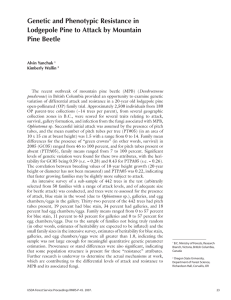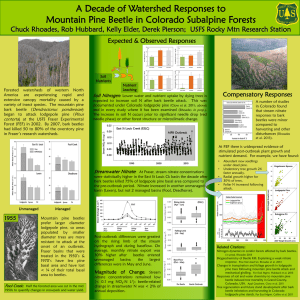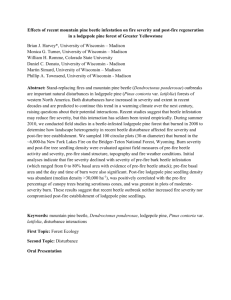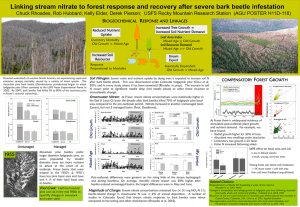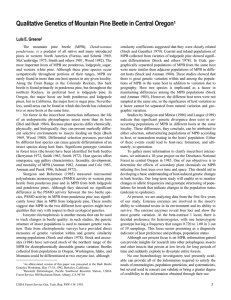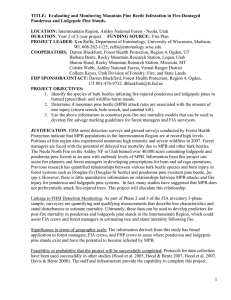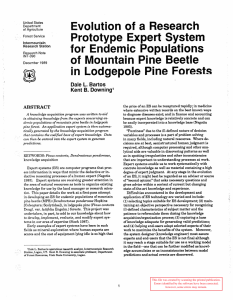Mountain Pine Beetle
advertisement
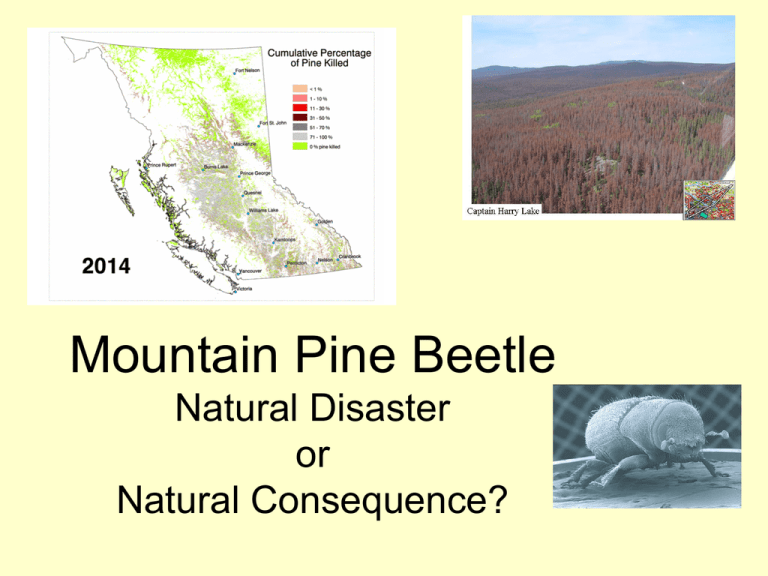
Mountain Pine Beetle Natural Disaster or Natural Consequence? Presentation Overview Meet the Mountain Pine Beetle (MPB) Importance of Lodgepole Pine in BC Life Cycle of the bug Green – Red – Gray Attack Population Dynamics Pine – Beetle – Fire Ecology Management Tactics Meet the MPB MPB - a small beetle, the size of a grain of rice Range western N.A. (and is now expanding) MPB is an important part of the ecosystem but it can have dramatic effects Preferred host is lodgepole pine Importance of Lodgepole Pine in BC BC – has a vast amount of lodgepole pine Some figures: 95 million ha (hectares) – size of BC 60 million ha – forested land 25 million ha – “operational forests” 15 million ha – lodgepole pine forest (~25% of BC’s forest) 13.5 million ha – MPB outbreak 0.2 million ha harvested per year When the outbreak is finished … 80% of the mature lodgepole pine in BC will be dead The Outbreak !! Videos – Ministry of Forests Cumulative Damage –of current outbreak (from 1999) After viewing an animation, when you hit the “back” button to return to this presentation you may see a window that asks whether you want to open, save or cancel – select open to return to this slide. Life Cycle Typical 4 stages of an insect (with complete metamorphosis): Adult Egg Larva Pupa Adult Adults emerge from under the bark in late summer Need to fly! Female seeks out a suitable host Larger (older) pine is preferred (kairomones) Once suitable host is found … pheromones female-perfume & males-cologne (=party time!) Mating pair then tunnels into the cambial zone Inoculate tree with blue stain fungus “No vacancy” pheromone once tree is fully occupied Egg Parents bore a gallery in the inner bark / cambial region Gallery is vertical Eggs are laid alternately along the sides of the gallery Larva Larva hatch after 1-2 weeks Larva create feeding tunnels at right angles Inner bark (phloem) is full of sugar! Larva overwinter under the bark … … and continue feeding next spring Pupa Pupal stage occurs the following year Takes about 2-4 weeks to change from a larva to an adult Life Cycle Review 4) Next Summer (next generation of adults emerge) 1) Summer (adults emerge & attack) 3) Next Spring (larva continue feeding, then pupate) 2) Over winter (as larva under the bark) Blue Stain Fungus Ceratocystis spp. (Ophiostoma) Ascomycetes (not a decay fungus) Brought in with the beetle Fungus infects sapwood Blocks water flow Reduces ability to ‘pitch out’ beetle Retains moisture – good for beetle brood Provides critical nutrition for young adults Green – Red – Gray Attack In the year a pine tree is attacked (summer) it remains green The following year it dies … and turns bright red (but beetles are gone) After that the foliage turns gray and falls off Only the green attack trees contain beetles Susceptible Stands Susceptibility increases with Age (>80 years are at highest risk) Size (> 25 cm diameter @ breast ht.) Stand composition (higher % of pine, higher risk) Stand density (750 – 1,500 trees/ha) Temperature (lower latitude/elevation, higher risk) Population Dynamics (4 Stages) 4 Stages: Factors favoring the outbreak Abundant food source (Pl forest) Drought stress (late ’90’s and 2003) Endemic – “normal” level – natural thinning agent Incipient – building phase Epidemic – outbreak! – stand replacing agent Collapse (back to endemic) Nice weather for beetle flight (summer) Mild winters Collapse Factors Lack of food Cold weather -40C ‘spike’, -30C prolonged, -20C in shoulder season Reminder This outbreak is the largest in BC recorded history After it is done … ~80% of the lodgepole pine will be dead Reasons for outbreak: Abundance of pine Mild winters Warm summers MPB – Fire – Lodgepole Pine Fire & the MPB play a complex role in regenerating lodgepole pine (video) you will have the option to download a video from the Canadian Forest Service (CFS) web site; video is about 5 minutes and VERY good after viewing the video, when you hit the “back” button to return to this presentation, you may see a window that asks whether you want to open, save or cancel – select open to return to this slide Low intensity fires act as a thinning agent High intensity fires act as a stand replacing agent We fight fires … so we now have denser (more stressed) stands AND we have more area with older lodgepole pine than ever before (3 x’s) Natural fires ~500,000 ha … now ~23,000 ha fire Remember the MPB likes older, stressed lodgepole pine Management Options – aimed at MPB Annual Monitoring (aerial/ground surveys, pheromone traps) Mass Trapping “Go after the beetle” – often with other trtmts (with pheromones, ineffective in epidemic) Sanitation Logging – a control tactic (get the green attack before beetle flight) Spot Treatment – for isolated patches (insecticide (MSMA) or fall & burn, before flight) Broadcast Fire - mimic nature (with control measures) Hauling Restrictions – no hauling during beetle flight (less of an issue in vast epidemic) Salvage Logging – not a control tactic (get the red/gray attacked trees) Abandon – for out of control epidemic (just “walk away”) Protective Insecticide – for urban setting (Carbaryl (Sevin) on trunk before flight) Pheromone Repellant - verbenone, looks promising (“no vacancy” scent) Trunk Screen - fiberglass wrapped around trunk – urban setting Management – Aimed at Pine Log most susceptible stands first (80+ yr, 25+ cm dbh, etc.) Create an age class mosaic within a watershed Utilize a shorter rotation (harvest) age Promote mixed species (planting & spacing) Remove pine from mixed stands (during outbreak) (speed succession) “Beetle proof” pine stands reduce density <500 sph (light/temp, wind, vigour) Summary Outbreaks result from an abundant food source and favourable weather (warm summers & mild winters) In spite of best efforts, outbreaks will occur … they are natural Best time for action is at the incipient stage Long term management should focus on lodgepole pine, not the MPB This presentation was brought to by… the Tree Doctor That’s all folks!
